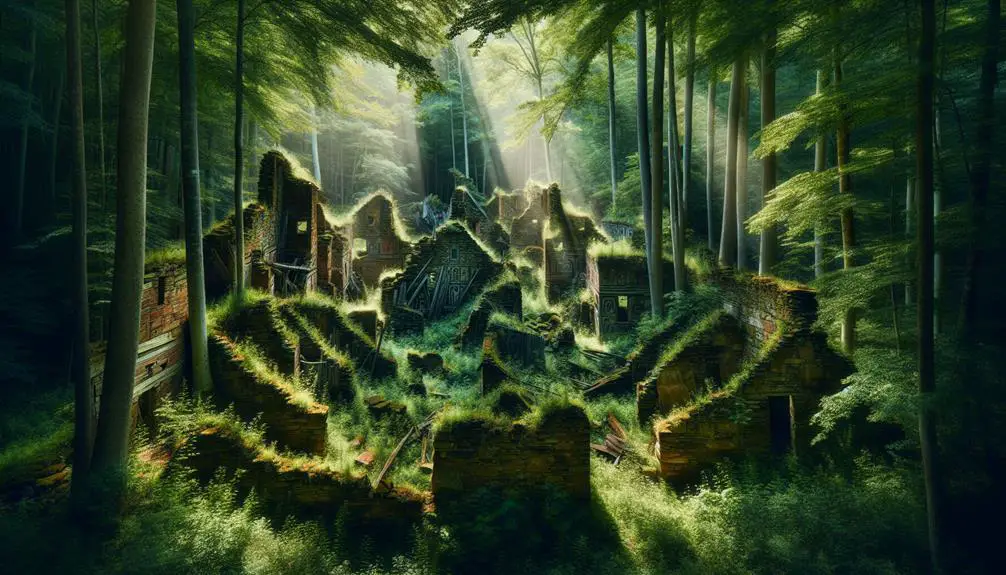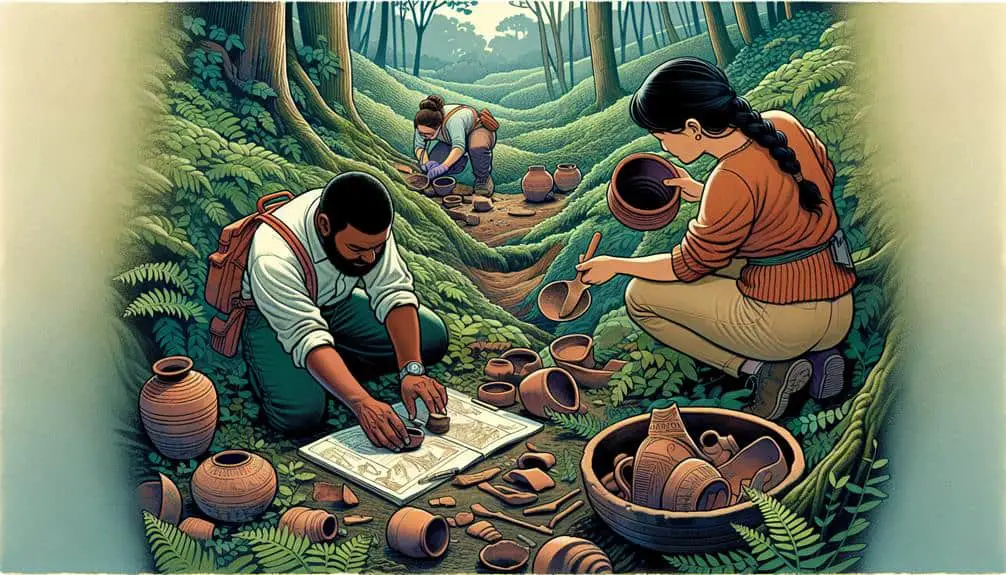Enter a world where ancient Native American wonders await in the USA. Explore over 130,000 archaeological sites, revealing fascinating stories of thriving civilizations. Discover the mysterious Anasazi Cliff Dwellings, perched precariously with stunning views and advanced construction techniques. Uncover the enigmatic Puebloan Adobe Villages, showcasing meticulous craftsmanship and deep cultural connections. Marvel at the haunting Hohokam Pit Houses, witnesses to ancient ingenuity and desert adaptation. Encounter the lost Mississippian Mound Complexes, revealing urban planning and spiritual practices. Explore the forgotten Hopewell Earthworks, intricate designs hinting at sophisticated engineering. The ancient past beckons with tales of community, spirituality, and resilience.
Key Points
- Anasazi Cliff Dwellings offer cultural insights and breathtaking views.
- Puebloan Adobe Villages reveal meticulous craftsmanship and environmental harmony.
- Hohokam Pit Houses showcase ancient desert adaptation and architectural ingenuity.
- Mississippian Mound Complexes reflect urban planning and spiritual ties.
- Hopewell Earthworks feature intricate designs and ceremonial significance.
Mysterious Anasazi Cliff Dwellings
Perched precariously on the cliff's edge, the Mysterious Anasazi Cliff Dwellings offer a fascinating glimpse into the lives of ancient Native Americans in the USA. This ancient architecture, crafted into the natural rock formations, holds immense cultural significance, reflecting the ingenuity and resourcefulness of the Anasazi people. As you explore these cliff dwellings, imagine the daily activities that once took place within these stone walls. The layout of the rooms, the strategic positioning for defense, and the artistic elements carved into the walls all provide clues about the lifestyle and beliefs of these early inhabitants.
Staring out from these dwellings, you can appreciate the breathtaking views that must have inspired a sense of awe and reverence in the Anasazi. The intricate construction techniques used to build these structures without modern tools demonstrate the advanced knowledge and skills possessed by these ancient peoples. Each step you take among these ruins connects you to a time long past, inviting you to unravel the mysteries of a civilization that thrived in harmony with its environment.
Enigmatic Puebloan Adobe Villages
Nestled amidst the rugged landscapes of the American Southwest, the Enigmatic Puebloan Adobe Villages stand as demonstrations to the architectural prowess and cultural complexity of the ancient Pueblo peoples. These archaeological treasures reveal the ingenuity and artistry of a civilization that thrived in harmony with the land. The adobe structures, made of sun-dried bricks and wooden beams, showcase meticulous craftsmanship that has stood the test of time.
Exploring these villages exposes a rich tapestry of history and tradition. The layout of the villages reflects a deep connection to the surrounding environment, with carefully planned structures that blend seamlessly with the natural terrain. Archaeological discoveries in these sites have unearthed pottery, tools, and artwork that provide insights into the daily lives and beliefs of the Puebloan people.
The cultural significance of these villages can't be overstated. They serve as windows into a past where community, spirituality, and resilience were paramount. Each crumbling wall and weathered doorway whispers stories of a bygone era, inviting you to unravel the mysteries of the ancient Pueblo civilizations.
Haunting Hohokam Pit Houses
Delving into the depths of the arid Arizona landscape reveals the haunting presence of the Hohokam Pit Houses, offering a glimpse into the ancient living spaces of a fascinating civilization. These structures, built by the Hohokam people over a thousand years ago, represent a marvel of ancient architecture and pose intriguing archaeological mysteries.
The Hohokam Pit Houses were semi-subterranean dwellings constructed by digging shallow pits into the ground and then building walls with materials like mud and stone. The roofs were typically made from branches, thatch, and mud. This unique architectural style helped the Hohokam people adapt to the desert climate, providing insulation from both the scorching heat of the day and the cold nights.
Exploring these pit houses today, you can't help but marvel at the ingenuity of the ancient builders. The mysteries surrounding these structures, like the purpose of specific features or the exact social organization of the Hohokam society, continue to intrigue archaeologists and historians alike. The Hohokam Pit Houses stand as proof of a bygone era, where innovation and survival were paramount.
Lost Mississippian Mound Complexes
Investigating the expansive American Southeast reveals the mysterious charm of the Lost Mississippian Mound Complexes, providing insight into the abundant cultural heritage of a vanished civilization. These archaeological wonders, characterized by large earthen mounds and intricate layouts, have captured the imagination of historians and archaeologists alike. Through ongoing archaeological excavations, researchers uncover the historical significance of these complex structures, shedding light on the societal organization, religious beliefs, and daily life of the Mississippian people.
The Lost Mississippian Mound Complexes stand as affirmations to the architectural prowess of their creators, showcasing a sophisticated understanding of urban planning and ceremonial spaces. These sites aren't merely remnants of the past; they serve as valuable tools for cultural preservation, allowing modern society to connect with the traditions and achievements of those who came before. The intricate patterns found within the mounds hint at a society deeply intertwined with spiritual beliefs and communal practices, offering a glimpse into a world that once thrived in harmony with its surroundings.
Forgotten Hopewell Earthworks
The Forgotten Hopewell Earthworks reveal a complex network of ancient earthworks and ceremonial spaces that offer a window into the rich cultural heritage of the Hopewell people. The intricate geometric designs and massive earthen structures reflect the sophisticated engineering and spiritual beliefs of the Hopewell culture. These earthworks, spread across the landscape, served as gathering places for rituals, trade, and social activities, showcasing the interconnectedness of various Hopewell settlements.
Preserving these Hopewell Earthworks is essential not only for understanding the history and customs of the Hopewell people but also for honoring their legacy and contributions to American indigenous cultures. Earthworks preservation involves ongoing efforts to protect these sites from natural erosion, urban development, and vandalism. By safeguarding these ancient structures, we make certain that future generations can continue to learn from and appreciate the ingenuity and artistry of the Hopewell civilization.
Explore these forgotten wonders and investigate into the mysteries of the Hopewell culture through the enduring remnants of their earthworks.
Frequently Asked Questions
How Did Native Americans Construct Their Dwellings and Villages Without Modern Tools and Machinery?
You'll be amazed by how Native Americans crafted their dwellings and villages without modern tools. Through ingenious construction techniques, preservation methods, and deep cultural practices, they fostered strong community connections while building lasting legacies.
What Significance Do These Ancient Ruins Hold for Modern Native American Tribes?
You cherish those ancient ruins, right? They hold the key to cultural preservation and ancestral connections. The significance lies in honoring traditions, feeling the spirits of your forefathers, and safeguarding your heritage.
What Evidence Suggests That These Ancient Civilizations Had Trade Networks With Other Indigenous Groups?
Evidence of ancient civilizations' trade networks with indigenous groups is found in artifacts like pottery. Cultural exchange through trade routes allowed for the sharing of craftsmanship techniques, materials, and styles, demonstrating interconnectedness among diverse communities.
Are There Any Ongoing Archaeological Excavations or Research Projects at These Sites?
Yes, ongoing archaeological excavations and research projects are uncovering new insights at these sites. Advanced excavation techniques aid in revealing hidden treasures while focusing on cultural preservation guarantees the integrity of these ancient ruins.
How Can Visitors Respectfully Engage With and Learn From These Sacred Sites Without Causing Harm or Disruption?
To respectfully engage with sacred sites, immerse yourself in their history, listen to local guides, and honor traditions. Avoid touching artifacts, stay on designated paths, and support cultural preservation efforts. Embrace learning with reverence.



